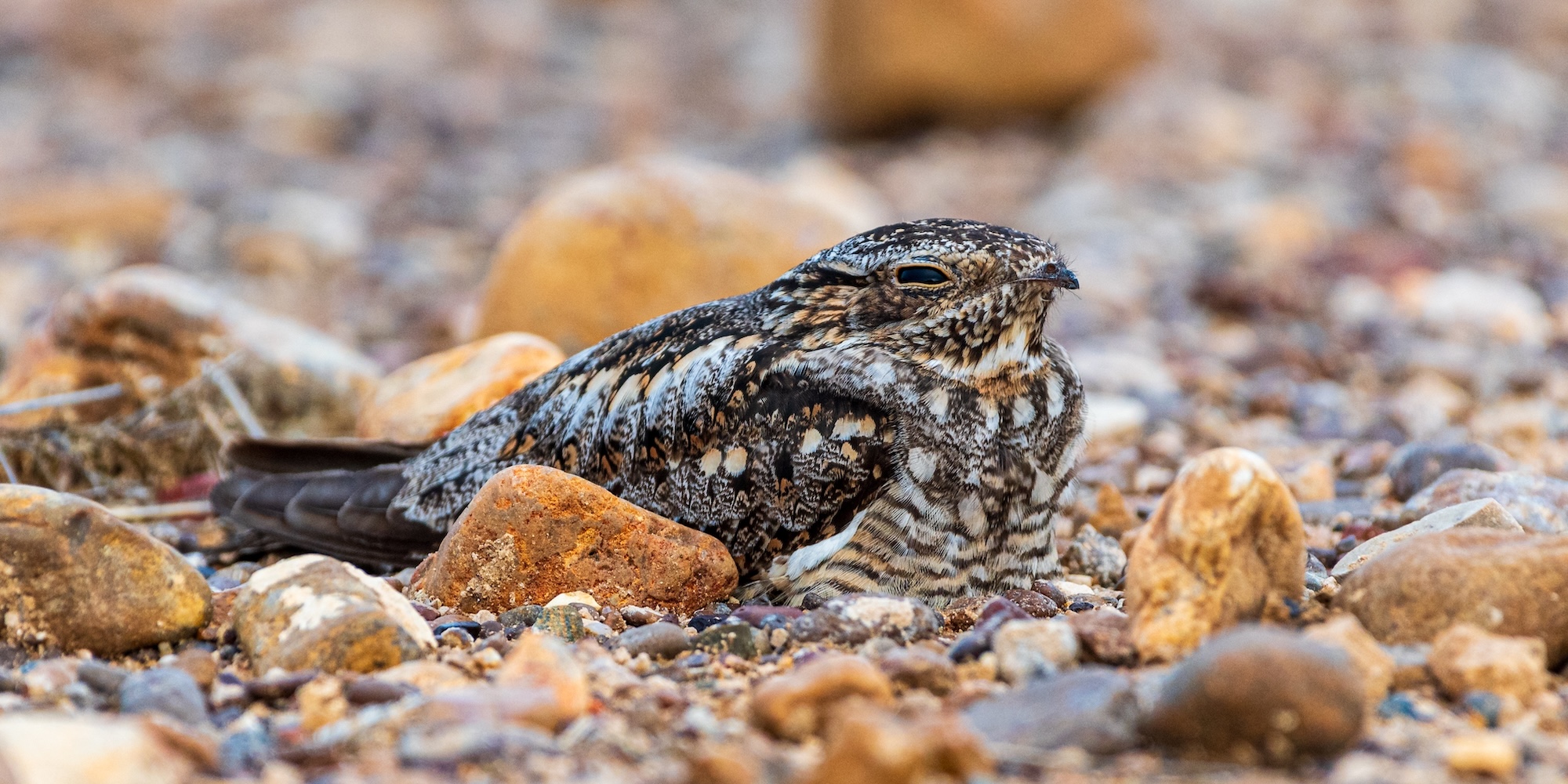The Nighthawks of the Middle Fork
Our Middle Fork manager, Kim Cunningham, loves Nighthawks.
If you’ve been on a trip with her before, maybe you’ve heard her talk about them. If not, be warned. To bring up the topic of this particular bird with Kim is to unleash a deluge of fun facts and personal anecdotes that will last at least 40 minutes.
And rightfully so. Nighthawks are seriously fascinating creatures and their regular appearances at dusk on the Middle Fork have made for prime entertainment on many a summer evening.
Here are 10 fun facts about Nighthawks, so that you can both join Kim and her reverie and enjoy them even more on your next Middle Fork trip.

ROW Adventures Middle Fork manager, Kim Cunningham, sharing an interpretive talk during a trip.
1. Their name is a total misnomer.
You might even go so far as to say that the name “Nighthawk” is a lie, as they are neither nocturnal nor hawks.
In fact, Nighthawks are what is known as crepuscular, which means that they are primarily active at dawn and dusk. The Common Nighthawk that we have on the Middle Fork are even known to hunt during midday in overcast weather, but almost never at night.
Whatsmore, Common Nighthawks are not hawks. Hawks, such as the Red-tailed Hawk are in the taxonomic family Accipitridae, which itself contains fascinating birds of prey all over the world. But Common Nighthawks or Chordeiles minor, are in the family Caprimulgidae, also sometimes called the Nightjars.
Perhaps they’re called hawks because they utilize a type of hunting called, “hawking,” in which a bird catches prey while in the air. Whatever the reason, these birds are just simply not hawks.
2. They are by no means only found on the Middle Fork of the Salmon.
These birds spend their breeding season all over North America in both town and country. They can often be seen at night hunting in open country at about the level of the tree tops. We see them almost every night on the Middle Fork before their migration, because there is a healthy population of them in the Frank Church Wilderness Area. In wilderness areas where important habitat is well protected, animal populations fare better than those that live in cities or agricultural areas.

3. They have one of the longest migrations of any bird species, and they begin their fall migration much earlier than most.
Nighthawks winter in South America, primarily in Brazil and the Amazon basin. (This is itself fascinating, given the fact that these birds need open habitat in order to hunt. The Amazon forest, as you may guess, is not an open habitat). In late spring, Nighthawks begin their migration north, where they follow a concentrated route along the Gulf of Mexico and the Mississippi Fly Way, before spreading out east and west all across North America for their breeding season.
Come August, their chicks are strong enough to make the journey south, and their genes tell them that it is to start their migration. For us, this is the time that they are easiest to spot all over the U.S., flying southbound in flocks both large and small.
4. Speaking of the breeding season, Nighthawks don’t make nests!
Instead, they lay their eggs on bare ground, often on dirt, sand, gravel or exposed rock. This is likely due to the fact that they are so well camouflaged with their rufous coloring that they are able to hide themselves and their young in plain sight.
5. They are sometimes found really far outside of their native range.
There’s a lot of reasons why a bird may fly outside of its normal range, which is also known as vagrancy. There are three main reasons this happens. The first, called “spring overshoot” happens when they accidentally fly too far north and pass their breeding grounds. The second is called reverse migration, and is caused by a fluke in the genetic programming of their migration behavior, and can cause an individual to go the wrong way in the wrong season. And the last is drift migration, which happens when heavy wind blows birds off of their course and causes them to go way outside of their typical migration route. (When this happens in large numbers it's called fallout).
Whether it was because they got confused or were forced there by the wind, there have been confirmed sightings of Common Nighthawks as far away as Greenland, Iceland, the Azore Islands off of Portugal and several times in the British Isles.

6. Their flight behavior is absolutely iconic.
Nighthawks are aerial insectivores, which means that they hunt for insects while flying. Perhaps because of their size, the unique shape of their outstretched wings, or the large white spots on each wing, but their flight patterns are captivating. Imagine elegant swooping twirls and acrobatic dips and dives. Or better yet, come on a Middle Fork trip with us and see it for yourself!
7. Their mating behavior is also incredible.
Picture this: the male flies high above the female, calling continuously and getting her attention. He will then make a spectacular dive, peeling out of it at the last moment, sometimes just a few feet above the ground. As he does so, the air hits the primary feathers on his wings just right to create this fantastic booming sound. Pretty wild.
8. The oldest recorded Common Nighthawk was nine years old!
She was a female, found in Ohio.
9. Researchers have found Common Nighthawk fossils in North America that were 400,000 years old.

10. A not so fun fact: Common Nighthawks populations have been declining for a long time.
From 1970 to 2014, Nighthawk populations have dropped by 58 percent. There’s several likely reasons for this, including habitat loss, overuse of pesticides and collisions with vehicles. Again, this is perhaps why the populations in the Frank Church are still doing so well, they don’t have to contend with any of these threats.
However, there are things that all of us can do to support migratory bird populations, and to try to help Nighthawks become familiar neighborhood birds once again. Specifically, we can do what the American Bird Conservancy calls living a “Bird-Friendly life” which includes simple behaviors like landscaping with native plants, keeping your cat inside and minimizing your pesticide use.
Whether or not you join us on a Middle Fork of the Salmon trip next summer, keep an eye to the sky at dusk during the summertime. You just might see the Common Nighthawk diving and twirling against the fading daylight.



